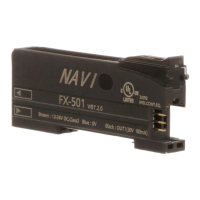
Do you have a question about the Panasonic FX-501 Series and is the answer not in the manual?
Provides critical safety warnings regarding personnel protection and proper usage.
Lists the international standards and regulations this product complies with.
Details the physical components, indicators, and button functions of the amplifier.
Instructions for installing the amplifier on a DIN rail and connecting fiber cables.
Procedure for connecting multiple amplifiers together using optional cables.
Illustrates the input/output circuits for various amplifier models.
Explains how to switch between RUN, CUSTOM, and PRO modes.
Introduces different teaching methods and their recommended applications.
Detailed steps for the primary 2-point teaching method.
Instructions for limit teaching, suitable for small objects or background interference.
Procedure for auto teaching, ideal for moving objects.
Method for setting threshold range using a shift amount.
Teaching methods for window comparator and hysteresis modes.
Guides on adjusting threshold values after initial teaching.
How to activate and deactivate the key lock to prevent accidental changes.
Procedure for switching between Light-ON and Dark-ON modes.
Explanation of how to use and set up the custom mode for quick access.
Explains how to access and navigate through the PRO mode menus.
Details on response time, timer, hysteresis, and shift amount settings.
Details on teaching lock, digital display, and emission power settings.
Details on timer range, data bank, and backup settings.
Details on copy settings, communication protocol, and external input.
Details on code setting, display adjustment, and interference prevention.
Details on sensing output modes, including normal, comparator, and differential.
Details on logic operation, threshold follow-up, and algorithm settings.
Detailed explanations for settings within PRO1, PRO2, and PRO3 menus.
Detailed explanations for settings within PRO4 and PRO5 menus.
Detailed explanations for settings within PRO6 menu.
Code tables for setting the green digital display for various functions.
Code tables for setting the red digital display for various functions.
Overview of functions enabled by optical communication, including copy and data bank.
Guidelines for mounting amplifiers to ensure proper optical communication.
Specific digital display code tables for the FX-5050-C2 model.
Conditions under which optical communication is not possible.
Methods to prevent interference between amplifiers using optical communication or frequency.
Lists common error codes and their corresponding remedies.
Important cautions regarding product usage, environment, and electrical safety.
Details on model numbers, supply voltage, and power consumption.
Technical specifications for output types, response times, and input signals.
Information on protection ratings, operating environment, materials, and cables.
